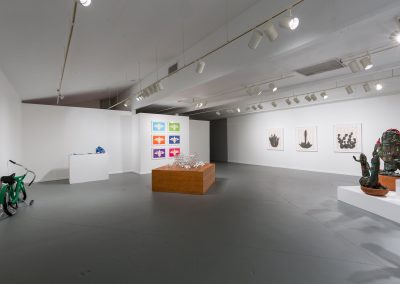Margarita Cabrera
What Art Can Do – The Collaborative Act of Making
Art League Houston
September 7 – November 2, 2019
Art League Houston (ALH) is proud to present the 2019 Texas Artist of the Year exhibition, What Art Can Do: Margarita Cabrera – The Collaborative Act of Making, featuring artwork by El Paso Artist Margarita Cabrera. A catalog focusing on Cabrera’s community based art projects is being published in conjunction with this exhibition, including an essay by Rocío Aranda-Alvarado, Program Officer, Creativity and Free Expression, with the Ford Foundation, New York, NY. Founded in 1983, ALH established the Texas Artist of the Year award as a dynamic project documenting contemporary Texas art history. The award recognizes artists who have demonstrated exceptional creativity and outstanding achievement, and whose work has had a significant and positive impact on contemporary visual art in Texas. Those who have been recognized have already produced a significant body of work and stand apart as leading figures and visionary talents within the field of contemporary art in Texas.
Margarita Cabrera is recognized for her sculpture and installations featuring a diverse range of media, including fabrics, steel, copper, wood and ceramics. Her most recent monumental, public art community sculpture was recently unveiled this year in San Antonio, TX: Árbol de la Vida: Memorias y Voces de la Tierra. The “Árbol” highlights a key component of Cabrera’s career – her desire for and the importance of community collaboration and engagement. Cabrera is an educator and instructor on historical Mexican handicraft methods, encouraging those around her to learn by giving them agency and opportunity through her collaborative projects. Cabrera’s artwork, from her soft-sculpture border plants depicting various species of cacti and desert flora, to her ceramic tractors and farm tools adorned with fragile butterflies, emphasize her concerns with social-political issues surrounding immigration, border politics, just work environments, and the importance of transforming the local community through art. She often engages with community members through her projects by including them in the act of creation, resulting in a collaborative, public work of art reflective of community energies and the surrounding environment. Her projects give a voice to local communities and artists, encouraging their personal growth, artistic education, and support of each other. Cabrera’s Texas Artist of the Year exhibition highlights her community based activism as well as her artistic creations over the years, exemplifying her devotion to historical Mexican craft traditions and the idea of art as a progressive vehicle for social and political change.
Cabrera states, “My work centers on social-political community issues including cultural identity, migration, violence, inclusivity, labor, and empowerment. I create sculptures made out of media ranging from steel, copper, wood, ceramics, and fabric. I have worked on a number of collaborative projects at the intersection of contemporary art practices, indigenous Mexican folk art and craft traditions, and US-Mexico relations. In addition to studying and preserving endangered cultural and craft traditions, these projects have served as active investigations into the creation of just working conditions and the protection of immigrant rights. My emphasis is on creating a social consciousness through my work, generating solutions to these problems through my art and empowering all members of highly diverse communities.
In recent years, I have especially focused on community art collaborations, producing work that has engaged international and local communities in transformative practices. With these works, we have created art pieces that serve as cultural and historical artifacts that value and document the experiences, struggles, and achievements of those who have found their way, often through migration and exceptional sacrifice, to new places where they now work to contribute meaningfully within their communities. This work is both individually and collectively inspiring to all participants and local populations.”








